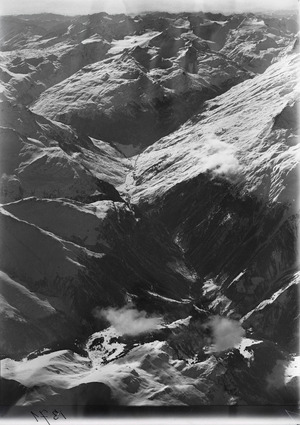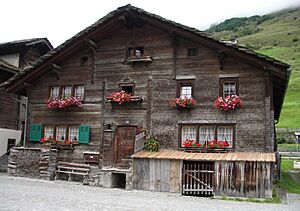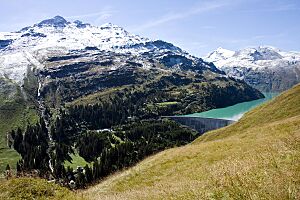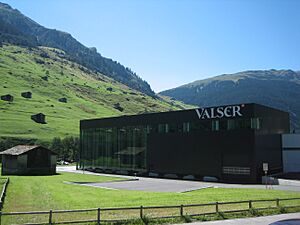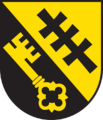Vals, Switzerland facts for kids
Quick facts for kids
Vals
|
||
|---|---|---|
 |
||
|
||
| Country | Switzerland | |
| Canton | Graubünden | |
| District | Surselva | |
| Area | ||
| • Total | 175.56 km2 (67.78 sq mi) | |
| Elevation | 1,252 m (4,108 ft) | |
| Population
(Dec 2020 )
|
||
| • Total | 946 | |
| • Density | 5.3885/km2 (13.956/sq mi) | |
| Postal code |
7132
|
|
| Surrounded by | Blenio (TI), Hinterrhein, Lumbrein, Nufenen, Safien, Vrin | |
Vals is a beautiful village and a municipality in Switzerland. It is located in the Surselva Region within the canton of Graubünden. On January 1, 2015, the nearby village of St. Martin joined with Vals to form one larger municipality.
Contents
History of Vals
People have lived in the Vals area for a very long time. Archeologists have found items from the Bronze Age and Iron Age. These finds were near the thermal baths and on the Valserberg slopes. This shows that people used this area even before written history began.
In the 11th and 12th centuries, the Valser valley was used by the local Romansh people. Vals was first mentioned in the mid-12th century as in Valle. Around 1290, there were about 4 to 7 farmhouses with sheep flocks here.
The Walser People Arrive
In the 13th century, a group of people called the Walser moved into the Valser valley. They came from the Wallis canton in southwest Switzerland. The Walser spoke a different kind of German. They were stopped from expanding further in 1457. This was when they were forbidden from marrying or buying land from the Romansh-speaking locals.
The Walser were only able to settle at the very end of the valley. This was because that area was not yet claimed. The Walser also brought their special house style with them. These houses used more wood than stone and had triangular roofs.
History of St. Martin
The village of St. Martin was settled around the 14th century. It was also settled by Walser immigrants. At first, it was owned by the Bishop of Chur. Later, it was controlled by the von Tersnaus and von Mont families.
In 1457, German-speaking people were not allowed to buy land or marry in the nearby village of Tersnaus. The church in St. Martin was built in 1345. It was first part of the church in Pleif. Later, in 1528, it came under the church in Tersnaus.
By 1671, the farms of St. Martin were a part of Tersnaus. But in 1878, St. Martin became its own independent municipality. The village stayed very rural. In 1972-73, it was the very last municipality in Switzerland to get electricity.
Vals' Coat of Arms
The coat of arms for Vals has a special design. It shows a black zig-zag line across a gold background. Below that, there is a gold key on a black background.
The key represents Saint Peter. He was shown on the old municipal seal. The zig-zag shape stands for the rights of the barons of Belmont.
Geography of Vals
Vals covers a total area of about 152.58 square kilometers (58.91 square miles). A large part of this land is used for farming. About 32.1% is for agriculture, and 12.2% is covered by forests.
A small part, about 0.6%, has buildings or roads. Rivers and lakes make up 2.2% of the land. The largest part, 52.9%, is unproductive land. This means it's mostly mountains, rocks, or glaciers.
Before 2017, Vals was in the Lugnez sub-district. Now, it is part of the Surselva Region. The main village of Vals is at an elevation of 1,252 meters (4,108 feet). There is also a small hamlet called Leis, which is higher up at 1,526 meters (5,007 feet).
The highest point in the municipality is Rheinwaldhorn. This mountain reaches 3,402 meters (11,161 feet) high. The Zervreilasee is a large reservoir in the valley. It was created by a dam on the Vals Rhine river.
People of Vals
Vals has a population of about 950 people. As of 2008, about 10.8% of the people living in Vals were from other countries. Over the last 10 years, the number of people living here has grown a little.
Most people in Vals speak German. About 94.4% of the population speaks German. The second most common language is Romansh, spoken by 2.3% of people. Italian is the third most common, spoken by 0.8%.
In Vals, about 70.3% of adults have finished high school or gone on to higher education. This could be a university or a special college.
Vals has a very low unemployment rate, which means most people have jobs. About 1.08% of people are unemployed. Many people work in farming, manufacturing, or services like tourism.
Things to See and Do
Vals is located in the beautiful Vals Valley. It is famous for its amazing thermal baths, called Therme Vals. These baths use natural hot spring water.
Vals is also where the popular Valser mineral water comes from. You can also find a special type of granite here called Valserstein. It has many minerals that make it sparkle.
Weather in Vals
Vals gets a good amount of rain each year. On average, it has 121.1 days of rain and about 1,185 millimeters (46.7 inches) of precipitation.
The wettest month is August. During this month, Vals gets about 144 millimeters (5.7 inches) of rain. It rains for about 12.6 days in August. May has the most rainy days, with an average of 12.8 days, but less rain overall.
The driest month is January. It only gets about 55 millimeters (2.2 inches) of rain. It still rains for about 12.6 days in January, but the amount of rain is much less.
Important Buildings
One special building in Vals is the double house at Nr. 81. This house is listed as a very important heritage site in Switzerland.
Images for kids
See also
 In Spanish: Vals (Grisones) para niños
In Spanish: Vals (Grisones) para niños





